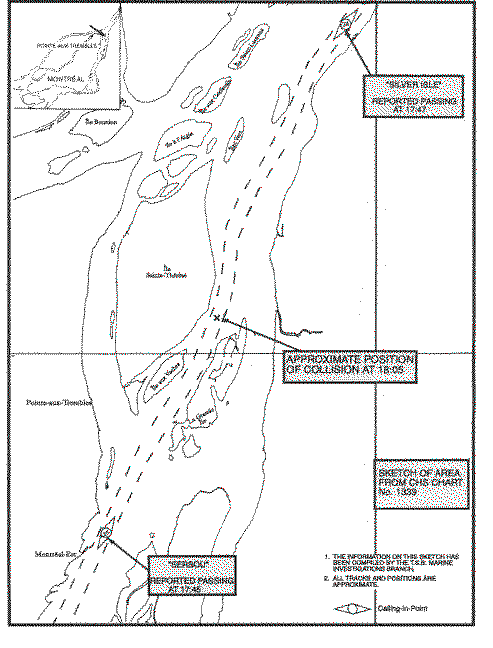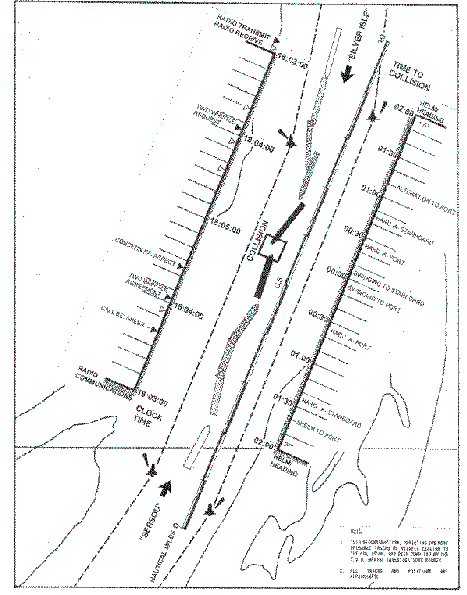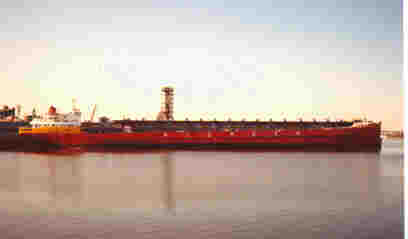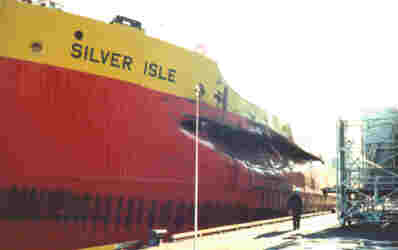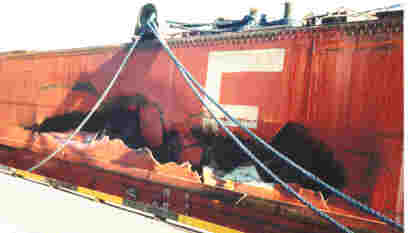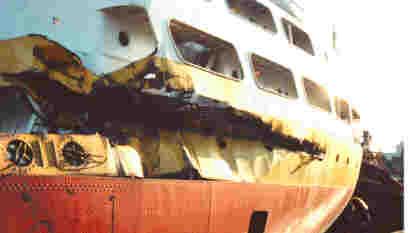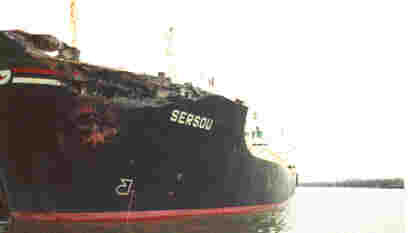Collision between the "SILVER ISLE" and the "SERSOU"
near Buoy M140
St. Lawrence River, Quebec
The Transportation Safety Board of Canada (TSB) investigated this occurrence for the purpose of advancing transportation safety. It is not the function of the Board to assign fault or determine civil or criminal liability. This report is not created for use in the context of legal, disciplinary or other proceedings. See Ownership and use of content. Masculine pronouns and position titles may be used to signify all genders to comply with the Canadian Transportation Accident Investigation and Safety Board Act (S.C. 1989, c. 3).
Summary
On 12 April 1991, at 1805, the Algerian-flag bulk carrier "SERSOU" and the Canadian-flag bulk carrier "SILVER ISLE" collided in the Chenal Île Sainte-Thérèse, a section of the St. Lawrence River ship channel within the limits of the port of Montreal. The collision occurred in daylight in relatively good visibility. No deaths, injuries, or environmental pollution resulted from the occurrence. Both vessels suffered heavy material damage.
The Board determined that the "SERSOU" and the "SILVER ISLE" collided primarily because the "SERSOU" developed a swing such that she was heading across the track of the "SILVER ISLE" as the two vessels were meeting. A contributing factor was the demand by the pilot of the "SILVER ISLE" that the vessels change to a non-conventional starboard-to-starboard passing arrangement under conditions of uncertainty and confusion as to whether such passing arrangement was finally agreed to before the vessels were in a situation of extremis. The situation was further complicated when the master of the "SILVER ISLE", called to the bridge late in the sequence of events, countermanded the orders of the pilot without having a full appreciation of the immediate situation and without notifying the "SERSOU".
1.0 Factual Information
1.1 Particulars of the Vessels
| SERSOU | SILVER ISLE | |
|---|---|---|
| Official number | AL-3442 | 319260 |
| Port of registry | Algiers, Algeria | Montreal, Quebec |
| Flag Type | Algerian | Canadian |
| Gross Tons | 19,377 | 18,127 |
| Length | 178.0 m | 217.5 m |
| Breadth | 27.44 m | 22.99 m |
| Draught | F2: 10.25 m | 3.12 m |
| (at time of occurrence) | A; 11.55 m | 6.25 m |
| Built | 1982 Japan | 1963 Ireland |
| Propulsion | 7,944 kW (10,800 BHP) diesel engine driving a fixed pitch propeller |
6,620 kW (8,820 BHP) diesel engine driving a controllable-pitch propeller |
| owners | Société nationale de transport maritime algérienne Algiers, Algeria |
Great Lakes Bulk Carriers Inc. St Catherines, Ontario |
1 Units of measurement in this report conform to International Maritime Organization (IMO) standards or, where there is no such standard, are expressed in the International System (SI) of units.
2 See Glossary for all abbreviations and acronyms.
3 All times are EDT (Coordinated Universal Time (UTC) minus four hours) unless otherwise stated.
4 Although the ship channel in this section of the river runs more north-south than east-west, it is the convention in the St. Lawrence River that the side of the river that would be on the port side of an upbound vessel is the "south shore".
1.2 History of the Voyage
At 17103 on 12 April 1991, the "SERSOU", which was bound for Oran, Algeria, with a full cargo of grain, left the port of Montreal, Quebec, after receiving departure clearance from the Canadian Coast Guard (CCG). This special authorization, which was contingent on a specific minimum water level in the river between Montreal and Quebec City, was required because of the vessel's deep draught of 11.6 m. She was proceeding at half-speed, approximately eight knots (kn) through the water (10.5 kn over the ground), and, at 1745, she advised Montreal Vessel Traffic Services (VTS) that she was passing calling-in point (CIP) No. 25 off Pointe-aux-Trembles, Quebec, at the east end of Montreal Island.
Meanwhile, approximately six miles downstream, the "SILVER ISLE" was upbound, in ballast, toward the Saint-Lambert Lock, en route to the Great Lakes. She was proceeding at her economical full speed, approximately 12.5 kn through the water against the 2.5 kn current (10 kn over the ground), and, at 1747, she advised Montreal VTS that she was passing CIP No. 24 off Cap Saint-Michel, Quebec. The vessels were in sight of each other and were closing at a combined speed of about 20.5 kn over the ground.
At about 1803, the upbound "SILVER ISLE" was approaching the lower end of the Chenal Île Sainte-Thérèse, steering 195· (G) (gyro error nil). That course would take her close past buoy M140 on the north side of the channel4 at which point the two vessels would be about seven cables apart and on almost reciprocal courses.
At about 1803, the downbound "SERSOU" was in the upper end and approximately on the centre line of the Chenal Île Sainte-Thérèse. There is contradictory evidence as to the intended course to be steered by the "SERSOU". According to the officer of the watch (OOW) and the helmsman, the course was 034· (G), but the pilot stated that the vessel was steering 024· (G) (gyro error nil). The line of the channel is 021½·-201½· and the intent was that the "SERSOU" would be allowed to gradually cross to the south side of the channel after making the small alteration of course of some 10· to port from the previous leg of the channel.
There is contradictory evidence as to what occurred at this point. The pilot of the "SERSOU" and those in charge of the navigation on the "SILVER ISLE" testified that the "SERSOU" developed a sheer to port. The "SERSOU" was seen to begin a swing to port, or to extend an existing swing to port, such that she was heading toward the north side of the channel. The OOW and the helmsman of the "SERSOU" deny that there was a swing to port, but the pilot noted that the rudder angle indicator registered 15· to port. The pilot ordered the helmsman to put the wheel hard-a-starboard and, at 1803:40, alerted the "SILVER ISLE" to the action he was taking. It can be inferred from the evidence that the heading of the "SERSOU" at this time was sufficiently across the channel, toward the north side, so as to cause concern to both of the pilots and the navigation personnel on the "SILVER ISLE".
Because of the deep draught of the "SERSOU" and the limited clearance beneath her keel, the swing to port was not easily counteracted and the heading was not quickly corrected. At 1803:53, the pilot of the "SILVER ISLE" insisted to the pilot of the "SERSOU" that the vessels pass starboard-to-starboard instead of effecting the conventional port-to-port passing. The pilot of the "SERSOU" refused because he had already started to bring his vessel toward the starboard side of the channel. At 1804:03, the pilot of the "SILVER ISLE" again insisted for a starboard-to- starboard passing, and, at 1804:07, the pilot of the "SERSOU" agreed, based on his perception of the other vessel's aspect. He ordered thehelm of the "SERSOU" hard over to port. At this point, the "SERSOU" had stopped swinging to port and was starting to swing to starboard. She had the "SILVER ISLE" directly ahead, and the starboard side of the "SILVER ISLE" was partly open. The "SILVER ISLE" was in the vicinity of buoy M140 when the two vessels agreed to a starboard- to-starboard passing.
Meanwhile, the OOW of the "SILVER ISLE" had advised the master, who was in his office, that he should come up to the bridge. The OOW then sounded the danger signal. When the master arrived on the bridge, he found the helm over to port, the "SILVER ISLE" swinging to port and the "SERSOU" at close quarters on his starboard bow. The "SERSOU" was two to three cables distant and slowly swinging to starboard toward the south side of the channel, across his vessel's path. As he believed his vessel to be in danger, he took over the conduct of the vessel from the pilot, ordered the wheel hard over to starboard, and sounded the general alarm. The "SILVER ISLE" gave no indication to the "SERSOU", either by radio or sound signal, that the "SILVER ISLE" was altering course to starboard.
As his vessel was now slowly beginning to swing to port in preparation for the agreed starboard-to-starboard passing, the pilot of the "SERSOU" was astounded to see the "SILVER ISLE" starting to turn to starboard. Accordingly, at 1804:23, he called the "SILVER ISLE" on the radio to ask for an explanation. The pilot of the "SILVER ISLE" replied that he was now going hard-a-port and ordered the helm hard over to port to lessen the angle of the impending impact.
The two vessels put their main engines to full speed astern, but to little effect; a collision was inevitable at that point. First, the forepart of the "SERSOU" struck the port bow of the "SILVER ISLE". As the two vessels passed each other, there was a second impact amidships and then a third one aft. The forecastle of the "SERSOU" heavily damaged three cabins and the crew's lounge on the "SILVER ISLE".
Following the collision, the master of the "SILVER ISLE" held his vessel's bow against the river bank for approximately six hours while inspection of the hull took place. The "SERSOU" continued on to Tracy, Quebec, for a hull inspection.
1.3 Injuries to Persons
No one was injured.
1.4 Damage
1.4.1 Damage to the Vessels
The "SILVER ISLE" sustained heavy damage on the port side forward, amidships and aft. The "SERSOU" also sustained heavy damage, but it was limited to the port bow.
1.4.2 Environmental Damage
There was no pollution or other damage to the environment as a result of the collision.
1.5 Certification
1.5.1 Vessel Certification
Both vessels were manned, certificated and equipped in accordance with existing regulations.
1.5.2 Personnel Certification
The members of the crews of the "SILVER ISLE" and the "SERSOU" who were directly involved in this occurrence held the required certificates, and the pilots were appropriately licensed.
1.6 Personnel History
1.6.1 Masters
The master of the "SILVER ISLE" had been going to sea since 1953, had been sailing as a master since 1978, and had been on the "SILVER ISLE" since the spring of 1991.
The master of the "SERSOU" had been employed in a seafaring capacity since 1954, had been sailing as a master since 1972, and had been on the "SERSOU" as master for the last seven months.
1.6.2 Officers
The OOW of the "SILVER ISLE" had been going to sea since 1959, had been sailing as a chief officer and a relieving master since 1988, and had been on the "SILVER ISLE" since the spring of 1991.
The OOW of the "SERSOU" had been employed in a seafaring capacity since 1976, had been sailing as a chief officer since 1982, and had been on the "SERSOU" since 1990.
1.6.3 Pilots
The pilot of the "SILVER ISLE", a Class A pilot for 17 years, had been given the assignment some four hours before the arrival of the vessel at Pointe des Ormes, Quebec. He boarded at approximately 1230, and his destination was the Saint-Lambert Lock. The pilot of the "SERSOU", a Class A pilot for 20 years, had been given his assignment four hours before the vessel's estimated departure time of 1630. He boarded the "SERSOU" at approximately 1500.
Both pilots had had a rest period in accordance with Laurentian Pilotage Authority guidelines, that is, a minimum of 10 hours.
1.7 Weather and Current Information
1.7.1 Weather as Recorded by the Vessels
The "SERSOU" recorded clear skies, five-mile visibility, no wind, calm sea and a temperature of 8·C.
The "SILVER ISLE" recorded clear skies, 15-mile visibility, south-west winds at five knots, calm sea and a temperature of 8·C.
1.7.2 Current
The tidal influence in this area is near zero and, therefore, was not a factor in the accident.
South-east of Île aux Vaches, Quebec, the current runs toward the north at an angle to the line of the channel. The current then turns toward the north-east in the area where the collision occurred, again at an angle to the line of the channel.
The current was about 2.5 kn in the area in which the collision occurred. The water level was 2.9 m above chart datum, to a total depth of 13.6 m.
1.8 Navigation Equipment
1.8.1 Vessels' Equipment
1.8.1.1 Mechanical and Electrical Systems
The propulsion and steering systems and all other machinery and equipment required by regulations on both vessels were in good working order and did not contribute to the collision.
After the collision, a test of the rudder of the "SERSOU" was conducted while the vessel was at anchor. The rudder took about 14 seconds to go from hard-a-starboard (35· rudder) to hard-a-port with two pumps in operation. A similar test was carried out on the "SILVER ISLE", but the time was not recorded. However, a time of 18 seconds is estimated for this type of vessel.
The course recorder on the "SERSOU" was operational, but it was not switched on at the time of the collision. The time-logging mechanism on the engine data logger was not working. The Sat-Nav on the "SERSOU" had been set for a speed of eight knots before the vessel left Montreal. At the time of the collision, the Sat-Nav was registering an incorrect position downstream from the actual location.
The "SILVER ISLE" was equipped with a course recorder, but it had not been used for some time.
Without course recorder data relating to rudder angles and heading changes, the reconstruction of events before the collision can only be approximated.
1.8.1.2 Charts
Both vessels carried the chart of the area that complied with the Charts and Publications Regulations; however, neither vessel was using it for reference or navigational purposes.
The "SILVER ISLE" had Canadian Hydrographic Service (CHS) chart No. 1352, which covers the sector where the collision took place; however, the smaller-scale chart No. 1339 was being used. The "SERSOU" also had CHS chart No. 1352, but was using the British Admiralty chart No. 422, which is a small-scale marine chart generally used for voyage planning.
1.8.2 Shore Aids
At the time of the collision, all buoys were in position, and no problems were reported with any of the shore navigation aids in the vicinity.
1.9 Radio Communications
1.9.1Inter-Ship
During a radio communication at approximately 1747, the pilot of the "SERSOU" informed the pilot of the "SILVER ISLE" that the "SERSOU" went down to 11.6. Because of the imprecise language, the pilot of the "SILVER ISLE" interpreted 11.6 as being the other vessel's speed, whereas it actually was her draught.
Voice recordings made by Montreal VTS indicate that a potentially dangerous situation had begun to develop by 1803:40, when the pilot of the "SERSOU" warned the "SILVER ISLE" by radio, to watch the "SERSOU" as the helm was hard over to starboard to counter the swing to port the vessel was experiencing.
A transcript of the conversation reveals how the situation developed.
1803:40 "SERSOU" Watch me closely, I'm hard-a-starboard
1803:53 "SILVER ISLE"Are you OK to pass? Two whistles5
1803:59 "SERSOU" No, not two whistles, she's coming back
1804:03 "SILVER ISLE"It's too late ... two whistles
1804:07 "SERSOU" OK, two whistles
1804:20 "SERSOU" Two whistles ... eh?
1804:21 "SILVER ISLE"What did you say?
1804:23 "SERSOU" What are you doing there, two whistles?
1804:25 "SILVER ISLE"Two whistles
1804:28 "SILVER ISLE"I'm going
hard-a-port. Hard- a-port
1804:32 "SERSOU" I'm hard-a-port too
1804:54 "SERSOU" ... you told me ... you asked me to go to port.
(TRANSLATION)
5 In the International Regulations for Preventing Collisions at Sea (Collision Regulations), the manoeuvring signal for a vessel that is altering course to port is two short blasts on the vessel's whistle. In the lexicon of mariners, particularly on the Great Lakes, the expression "two whistles" has come to mean that the mariner will leave the other vessel on his starboard hand.
At the time of this last call, the collision had either taken place or was just about to.
The communications were carried out in French, the first language of both pilots.
1.9.2 Vessel Traffic Services (VTS) and Coastal Radio Stations
The staff at the Montreal VTS Centre complied with operational procedures. Radio reception and transmission before, during and after the collision were normal. Montreal VTS did not attempt to contact the vessels because they were in sight of each other and communications between the two pilots were normal until just before the collision.
1.10 Emergency Equipment
The master of the "SILVER ISLE" sounded the general alarm just before the collision. Neither vessel had to use any life-saving or fire-fighting equipment.
1.11 Composition of the Bridge Watch on the Two Vessels
1.11.1 "SILVER ISLE"
The chief officer, who was the OOW, the pilot and a helmsman were present in the wheel- house of the "SILVER ISLE". The master arrived on the bridge shortly before the collision.
1.11.2 "SERSOU"
The chief officer, who was the OOW, the pilot and a helmsman were present in the wheel- house of the "SERSOU". The master, who was in his office, was not summoned.
1.11.3 The Role of the Officer of the Watch (OOW)
The CCG publication, Recommended Code of Nautical Procedures and Practices, states that the OOW is the master's representative and that his primary responsibility is the safe navigation of the ship.
When a pilot is on board, the OOW has similar responsibilities. The OOW must also work closely with the pilot, but if there is any doubt as to the pilot's intentions, the OOW should seek clarification from the pilot. If the OOW still has doubts, he should notify the master immediately and take whatever action is necessary before the master arrives.
1.12 Pilotage
1.12.1 The Role of the Pilot
In Canada, the Pilotage Act requires that, in a compulsory pilotage area, a licensed pilot or holder of a pilotage certificate shall have the conduct of any vessel subject to compulsory pilotage.
Pilots have a detailed knowledge of the unique conditions that prevail in their areas. They are retained to direct the navigation of a vessel, particularly in confined waters and port approaches, and to expedite berthing and unberthing manoeuvres.
The pilot is responsible to the master for the safe navigation of the vessel. However, the pilot has no other authority on board, and the master retains overall responsibility for the safety of his vessel.
1.13 Relieving the Pilot
Section 26 of the Pilotage Act states that "where the master ... believes ... that the actions of a licensed pilot ... are ... endangering the safety of the ship, the master may ... take the conduct of the ship from the licensed pilot." The Act continues, "where the master of a ship takes the conduct ... from a licensed pilot ... the master shall file, within three days ... a written report setting out the master's reasons therefor with the Authority."
The master of the "SILVER ISLE" relieved the pilot of the conduct of the vessel when he ordered starboard helm and countermanded the pilot's orders for the starboard-to-starboard passing arrangement. The master did not file the requisite written report with the pilotage authority.
1.14 The Role of Vessel Traffic Services (VTS)
A marine traffic regulator may, under specific conditions, issue a direction to a ship with which the ship must comply (unless specific circumstances exist), but there is no intention on the part of the CCG to attempt to navigate or manoeuvre ships from a shore station.
When the "SERSOU" called the "SILVER ISLE" at 1803:40, the staff at the Montreal VTS Centre started monitoring very closely the radar returns of the two vessels and continued to do so until the collision. The staff's observations made possible a reconstruction of the events.
1.15 Collision Regulations and Whistle Signals
Approaching vessels normally pass each other port-to-port. Rule 9 of the Collision Regulations covers vessels proceeding in narrow channels and states, in part, that "a vessel proceeding along ... a narrow channel ... shall keep ... to the ... limit of the channel ... which lies on her starboard side."
In this case, a Canadian Modification to Rule 9 was significant. It states that "the vessel proceeding with the current ... shall be the stand-on vessel and shall propose the place ... and ... side on which she intends to pass." Further, "the vessel proceeding against the current ... shall keep out of the way ... and hold as necessary to permit safe passing."
In this case, the "SERSOU" was the stand-on vessel. However, the pilot of the "SILVER ISLE", although this vessel was the give-way vessel, insisted on a starboard-to-starboard passing arrangement to the pilot of the "SERSOU".
The two vessels altered their passing arrangement on the radiotelephone in accordance with a Canadian Modification to Rule 34 of the Collision Regulations. The modification states that vessels "may use ... bridge-to-bridge radiotelephone instead of ... whistle signals to reach agreement in a meeting ... situation."
Rule 34 of the Collision Regulations requires that "when vessels are in sight of one another ... a vessel ... when manoeuvring ... shall indicate that manoeuvre by ... signals on her whistle." In this case, the "SILVER ISLE" did not sound a short blast to indicate that she was altering course to starboard when the master countermanded the pilot's order.
1.16 Personnel Communications
Communications between the pilots were in French. The OOW of the "SILVER ISLE" did not understand French and, therefore, did not understand what passing arrangements had been agreed to. When the pilot informed him of the intention to pass starboard-to-starboard, the OOW summoned the master to the bridge.
1.17 Position of the Collision
The exact position of the collision was not recorded by either vessel; however, other evidence indicates that it occurred slightly north of the centre line of the channel in the vicinity of the Île Sainte-Thérèse light. The channel is 244 m (800 feet) wide in this section, and there are no leading lights. After the collision, the master of the "SILVER ISLE" steered his vessel north and out of the channel to hold her upstream from the Île Sainte-Thérèse light pending an examination of the hull.
The pilot was the only person on the "SERSOU" who knew that the collision had taken place in the vicinity of the Île Sainte-Thérèse light. The OOW thought that it had occurred in the vicinity of Cap Saint-Michel, based on the Sat-Nav estimated position which was further to the east as a result of the equipment's estimated speed input.
1.18Alteration of Course by the "SILVER ISLE"
The times of the radio transmissions between the two pilots just before the collision were examined, with a view to establishing the timing of helm movements. This examination raised doubt as to whether the pilot of the "SILVER ISLE" had waited for an agreement with the pilot of the "SERSOU" before implementing his alteration of course to port to effect the starboard-to- starboard passing.
1.19 Headings of the Vessels and the Angle of Impact
The precise headings of the vessels at the time of the collision are not known. However, the damage indicates that the initial impact occurred at an angle of between 20· and 30·.
2.0 Analysis
2.1 Heading of the "SERSOU"
Statements made by the navigation personnel on the "SERSOU" (the OOW and the helmsman) disagreed with statements made by other witnesses on three main points: the intended course of the "SERSOU", the location of the collision, and whether the "SERSOU" was swinging to port across the channel or not.
With regard to the intended course, the pilot said that the heading was 024· G while the navigation personnel said that it was 034· G. The orientation of the channel in that vicinity is 021½·-201½·. As the channel is only 244 m wide, a vessel of the size and draught of the "SERSOU" at eight knots could not maintain a heading 12½· off the direction of the channel for longer than two and a quarter minutes without running out of the channel and grounding. A heading of 024· would have achieved the desired goal of bringing the "SERSOU" gradually over to the starboard side of the channel. Further, had the "SERSOU" been on a heading of 034·, her port side would have been open when viewed from the "SILVER ISLE". The personnel involved with the navigation of the "SILVER ISLE", who had an unrestricted view of the "SERSOU" from a distance of about one mile, said that the port side of the "SERSOU" was not open. It is considered that 024· is the most likely course that the pilot had ordered the helmsman to steer.
With respect to the position of the collision, the navigation personnel on the "SERSOU" stated that it occurred at Cap Saint-Michel, the location from which the "SILVER ISLE" had called in to the VTS at 1747, 18 minutes before. The pilot on the "SERSOU" and those involved with the navigation of the "SILVER ISLE" agreed that the collision took place in the vicinity of the Île Sainte-Thérèse light, and this was confirmed by the VTS. It is not considered that there is any doubt that the collision occurred near the Île Sainte-Thérèse light. Had the "SERSOU" been where her navigation personnel believed her to be, in the vicinity of Cap Saint-Michel, a course of 034· would have been appropriate for a downbound vessel.
The pilot of the "SERSOU" stated that the vessel had picked up a sheer or a swing to port, but the OOW and the helmsman said that she had not. The personnel involved with the navigation of the "SILVER ISLE" agreed with the version of events as given by the pilot of the "SERSOU" based on their continuous monitoring of the aspect of the "SERSOU". The "SERSOU" had just completed a minor course alteration to port and the pilot had found she was carrying 15· of port helm before he ordered the wheel hard over to starboard. The navigation personnel on the vessel had demonstrably not been monitoring the vessel's progress down the river properly. The OOW believed that the vessel was some three miles further downstream and, therefore, he was not in a position to appreciate whether or not the vessel had swung past the line of the axis of the channel. Based on the above, it is considered that, after rounding on to the Chenal Île Sainte-Thérèse, the "SERSOU" had swung past the intended heading, and to port of the alignment of the channel. This caused concern to the pilot on the "SERSOU" and to those in charge of the navigation of the "SILVER ISLE" and convinced them of the need to take action.
2.2 Change of Heading Experienced by the "SERSOU"
A vessel navigating in a narrow channel may develop a swing or possibly a sheer as a result of four main factors:
- Bank cushion or bank suction can cause a vessel to swing because of unequal hydrodynamic pressure on the bow and stern. It is unlikely that the swing experienced by the "SERSOU" was caused by bank suction because the vessel was in the centre of the channel.
- Shallow-water effect can necessitate a greater- than-normal helm angle when altering heading and cause a sheer or swing when vessels are heavily laden. The "SERSOU" was proceeding at a speed of 8 kn through the water and 10.5 kn over the ground, and her under-keel clearance was approximately 2.05 m aft. At that speed and with that clearance, the "SERSOU" should not have experienced manoeuvring difficulties.
- A localized cross-current can have an impact on only a portion of a vessel's hull. Reportedly, pilots had experienced such an effect previously in this area of the St. Lawrence River.
- Steering errors which can be made by an inexperienced or inattentive helmsman.
As no course recorder data are available, it can only be concluded that the sheer or swing experienced by the "SERSOU" was probably the result of one or both of the last two factors.
2.3 Collision Avoidance Options
Besides the actions taken, there were other options available to both vessels that might have allowed them to avert the collision.
2.3.1 "SILVER ISLE"
According to the Collision Regulations, the "SILVER ISLE" was the give-way vessel. She was also the more manoeuvrable of the two vessels.
One of the options available to the "SILVER ISLE" would have been to reduce speed, thus giving those on the "SERSOU" more time to control their vessel's swing before the vessels met. Another option would have been to alter course to starboard, even to the point of going outside the channel. The water level was high at the area of impact, and the "SILVER ISLE", in her light condition, had sufficient sea-room outside the channel for a safe port-to-port passage. A third option would have been a combination of course and speed alterations.
2.3.2 "SERSOU"
The "SERSOU" was the stand-on vessel and had the right and responsibility to set the location and manner of passing. She was also, by far, the more heavily laden of the two vessels. Nonetheless, the pilot of the "SERSOU" allowed the pilot of the "SILVER ISLE" to persuade him to change the passing arrangement when he was already taking steps to correct the swing which had been picked up by the "SERSOU".
The "SERSOU", which was proceeding at half-speed, had plenty of power in reserve that could have been used to improve the effectiveness of the vessel's rudder and thereby accelerate her response to the correction of the swing.
2.4 Action by the Master of the "SILVER ISLE"
When the master of the "SILVER ISLE" arrived on the bridge after being summoned by the OOW, he found his vessel and the "SERSOU" two to three cables apart, in a close-quarters situation. The "SILVER ISLE" was swinging to port and the "SERSOU" was still swinging slowly to starboard toward the south side of the channel, across the path of the "SILVER ISLE". As the OOW could not fully explain what was going on since the passing arrangements had been made in French, a language that he did not understand, and as the pilot, who had the conduct of the vessel, was fully occupied in talking on the radio and trying to avert a collision, the master could not gain a full understanding of the developing situation as it existed. His immediate assessment was that the two vessels could not clear each other and pass starboard-to-starboard. Therefore, using his best professional judgement, and without knowing that the wheel of the "SERSOU" was hard over to port, he ordered an immediate turn to starboard, effectively countermanding the pilots' agreed-upon procedure.
2.5 Sounding the General Alarm
When the master of the "SILVER ISLE" sounded the general alarm, he provided valuable warning time to crew members who were in the cabins and the lounge on the port side aft. That part of the "SILVER ISLE" sustained heavy damage in the collision. The master's action likely saved lives.
3.0 Findings
3.1 Findings
- As the two vessels closed for a normal port-to-port meeting, the deeply laden "SERSOU" developed a swing to port.
- The cause of the vessel swinging to port was not determined.
- The "SERSOU" was unable to correct the swing quickly and did not use reserve power to counteract it.
- The pilot of the "SILVER ISLE" insisted on a starboard-to-starboard passing arrangement.
- The pilot of the "SERSOU", the vessel which had the right-of-way, at first resisted then agreed to the starboard-to-starboard passing arrangement.
- The master of the "SILVER ISLE" countermanded an order by his pilot without having a full understanding of the navigational situation at that moment and without notifying the "SERSOU" of his action.
- Other than changing heading, neither vessel took any action to avert a collision until their main engines were put astern immediately before the collision.
- The collision situation developed in somewhat less than two minutes.
- The vessels' course recorders were not operating, and there is no regulatory requirement that they should have been.
- The OOW of the "SERSOU" did not know the precise position of his vessel.
3.2 Causes
The "SERSOU" and the "SILVER ISLE" collided primarily because the "SERSOU" developed a swing such that she was heading across the track of the "SILVER ISLE" as the two vessels were meeting. A contributing factor was the demand by the pilot of the "SILVER ISLE" that the vessels change to a non-conventional starboard-to-starboard passing arrangement under conditions of uncertainty and confusion as to whether such passing arrangement was finally agreed to before the vessels were in a situation of extremis. The situation was further complicated when the master of the "SILVER ISLE", called to the bridge late in the sequence of events, countermanded the orders of the pilot without having a full appreciation of the immediate situation and without notifying the "SERSOU".
4.0 Safety Action
4.1 Action Taken
4.1.1 Bridge Resource Management
In four previous occurrence reports, the Board has expressed its concerns about the adequacy of bridge resource management (BRM) practices on vessels in Canadian waters. Three of the four occurrences involved foreign vessels, one involved a Canadian vessel6. A general lack of interaction between the officer of the watch (OOW), master and pilot on the bridge, interrupted procedures, inadequate bridge-to-bridge communication, lack of situational awareness and of teamwork between the pilots and ships' officers, etc. have been contributing factors in such occurrences.
Recognizing the need for improved BRM practices, at least one large Canadian shipping company is currently implementing a formal BRM training program for its officers.
In view of the frequency of occurrences of a similar nature, the Board is currently studying the operational relationships between ships' masters,
6 The Yugoslavian bulk carrier "MALINSKA" (TSB Report #M91C2009), the Swedish Ro-Ro/ container carrier "CONCERT EXPRESS" (TSB Report #M92M4023), the Norwegian chemical tanker "LAKE ANINA" (TSB Report #M90L3016), and the Canadian product tanker "EASTERN SHELL" (TSB Report #M91C2008).
OOWs and marine pilots. Based on the findings of this study, the Board will make appropriate safety recommendations to improve the effectiveness of BRM practices on both foreign and domestic vessels in Canadian waters.
This report concludes the Transportation Safety Board's investigation into this occurrence. Consequently, the Board, consisting of Chairperson, John W. Stants, and members Gerald E. Bennett, Zita Brunet, the Hon. Wilfred R. DuPont and Hugh MacNeil, authorized the release of this report on .
5.0 Appendices
Appendices
Appendix A - Chart--Area of Occurrence
Appendix B - Photographs
Appendix C - Glossary
- A
- aft
- bank suction
- Lateral force acting on a vessel because of unequal hydrodynamic pressure on the hull in restricted and shallow waters.
- BHP
- brake horsepower
- BRM
- bridge resource management
- C
- Celsius
- cable
- one tenth of a nautical mile (185 m)
- CCG
- Canadian Coast Guard
- chart datum
- Plane below which the tide seldom falls and to which depth information on a chart is reduced.
- CHS
- Canadian Hydrographic Service
- CIP
- calling - in point
- danger signal
- At least five short and rapid blasts on the whistle, questioning the intentions of the other vessel.
- EDT
- eastern daylight time
- F
- forward
- G
- gyro (degrees)
- give-way vessel
- Vessel required by the Collision Regulations to yield right - of - way.
- IMO
- International Maritime Organization
- kn
- knot(s): nautical mile(s) per hour
- m
- metre(s)
- OOW
- officer of the watch
- open
- Angled so as to be visible.
- Sat-Nav
- Navigational system using satellite signals to establish a vessel's position.
- sheer
- inadvertent swing
- SI
- International System (of units)
- stand-on vessel
- Vessel having the right-of-way under the Collision Regulations.
- swing
- change of heading
- TSB
- Transportation Safety Board of Canada
- under-keel clearance
- Excess of water depth over draught.
- UTC
- Coordinated Universal Time
- VTS
- Vessel Traffic Services
- °
- degree(s)
